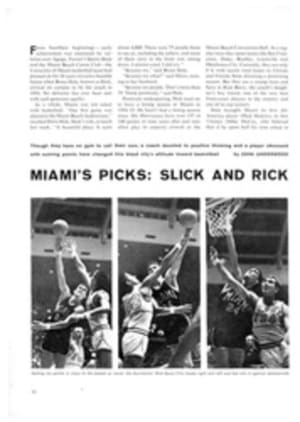
A Wild Time on the Tracks
Britain has an estimated million loco-spotters, all madly keen. With satchels crammed with sandwiches and soda pop, they hover around railways collecting locomotive stock numbers and names. They form a hungry market for recordings of such esoteric sounds as puffing, whistling and hooting in quantities that would be the envy of many a pop singer. They enlist in specialist clubs, travel in special trains along disused lines and revel in the romance of express services like the Atlantic Coast Express, the Red Dragon, the Queen of Scots and the Red Rose. In a compact country where few live far from a main-line railway and there are still about 8,000 steam locomotives in action, loco-spotting is as natural a British sport as cricket.
Collectors, who write down numbers from the sides of locomotives as they spot them, usually get the bug at the age of 6 and shake it off by 14. In the intervening years their love affair with railways is intense. Some get so firmly snared in the pastime's enveloping concern with classes, engine weights, wheel arrangements and general locomotive construction that they never escape. Britain's champion spotter is a 40-year-old Cambridge printer, Gerald Tweedie, who has seen all of 25,000 steam engines including Stephenson's Rocket.
Tweedie talks with the rapid rhythm of a train at top speed and has traveled over 80,000 miles in endless search for trains. "Around about 1950," he recalls, "when I had several thousand numbers, I suddenly got the urge to put on steam and try to get every steam-engine number there is. I have spent all my spare time, holidays and money on it."
Loco-spotters first emerged in significant numbers during World War II, when the hobby was commonly known as "copping locos." For some time a highly disorganized flock, they made life a burden for railway officials. They not only amassed numbers in their notebooks but put pennies on the lines, scooping up the battered coins as souvenirs after trains had passed. They wandered through tunnels in their pursuit, hopped on slow-moving trains, marched across the metals and occasionally interfered with signal wires. One 9-year-old, fined £l for putting a stone on a track that would have derailed the next train along if a signalman had not seen it, explained in court that because he was shortsighted it was difficult for him to read the number of a speeding locomotive, and he merely wanted to slow up the traffic. Another youngster was discovered lying nonchalantly on his back in the middle of the main Manchester-to-London line "listening out for trains." Other culprits collected the labels from goods vans in addition to locomotive numbers and caused chaos with deliveries. At Tamworth, a main-line intersection where any alert loco-spotter could see 80 express trains a day, so many boys flooded the platforms they simply spilled off the ends.
The Manchester Guardian ran a lead article on "The Tamworth Martyrs," and newspaper correspondence columns vibrated to some heated exchanges over loco-spotters. In general, the argument ran along the lines of whether it was better to keep boys off the streets and on the rails, or off the rails and on the streets. It was an enthusiast called Ian Allan who finally calmed the eruption. He founded a loco-spotters club with a single rule that insisted members be well behaved. Today it boasts over 400,000 reasonably decorous loco-spotters.
Ian Allan published some checklists of locomotives for enthusiasts during the war. When peace came he formed a company to move in on a big scale. His hobby has since turned into a considerable business venture, currently handling 150 different books on everything from trains to aircraft, cars, buses, trams, ships and rockets, which people also like to spot. From behind a large curved desk in an office hung with train pictures, Allan also controls the destinies of six related magazines and such side products as loco-spotters' pencils and china-ware with a train motif. Ian Allan's Modem Railways has a monthly circulation of 70,000, the largest of any such magazine in the world. All his publications sell 6 million annually.
Firmly placed in the driving cabin, Allan, at 41, simply explained his success—his undying interest in trains. His favorite task is to lead a loco-spotters' excursion, 500 excited individuals. An outing normally includes a tour around a railway works. "I don't think," remarks Ian Allan with cheerful faith, "that we've lost anybody yet."
Once loco-spotters grow into adulthood they rarely care to continue to be called just that. Their interest in Railways may continue unabated but is more delicately attuned to all its aspects, beyond the sole thrill of collecting numbers like matchbox tops. For instance, a middle-aged London stamp dealer, Peter Walker, who has his shop wedged beneath the noisy tracks leading into a large station, likes standing on a bridge and meditatively staring at a railway tapering away into the far horizon. Walker holds that there is nothing quite like catching "a good sniff of that first puff of smoke as a steamer rushes through beneath you." That whiff of coal, hot oil and steam delights him.
There is no end to the line for mature loco-spotters. In Surrey there is a quantity surveyor who had track laid in his garden and installed two nine-ton locomotives. And probably one of the world's most energetic train lovers is a British model railwayman who rises at 7 each morning to send off a laborers' special and hurries home at lunchtime to run a midday express. In the evening it is trains all the time. This same fan has a printed timetable which, come fog, spring cleaning or flu, he adheres to rigidly. He runs weekend excursions and in the fall switches to a winter schedule.
One cloud, in the form of the diesel engine, looms over loco-spotters, but Ian Allan is convinced it has a silver lining. Gradually steam locomotives are being replaced in Britain. Ten diesels are not worth the puff from a steamer to today's spotters. But there will be a generation, Ian Allan points out optimistically, that will have known nothing better. He is counting on them, and so is champion Tweedie. He has already collected the numbers of every main-line diesel so far in existence.

